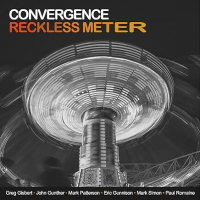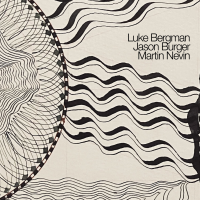Home » Jazz Articles » Album Review » Pat Bianchi: Something to Say: The Music of Stevie Wonder
Pat Bianchi: Something to Say: The Music of Stevie Wonder
Pat Bianchi is a long time Hammond B-3 player who is quietly earning a place for himself among the great jazz organists. His playing is less of a rodeo than others, but he is highly creative and inventive, and he is a master of the instrument. His intensive learning at the Eastman and Berklee Schools of Music informs his special craftsmanship, precision and musical ear. His trio follows his lead with a collective sound and interaction that is warm, flowing, and sophisticated. Along with guest appearances by Escoffery on two of the tracks, they make the album a sheer delight.
Stevie Wonder came up in the Detroit of the 1950s-1960s which was a hub of jazz styles, especially bebop, and the development of the "Motown Sound," which integrated R&B with soul, which added the emotional intensity of gospel to the music. Yet Wonder is steeped in jazz. His first studio album, The Jazz Soul of Little Stevie (Tamla, 1962), released when the artist was 12, consisted entirely of instrumentals and showed his early passion for jazz. Accompanied by a knockout big band, he improvises on the harmonica and bongos like a seasoned veteran. A short time later, when he topped both the soul and pop charts, jazz continued to influence the inimitable way in which Wonder composed and performed.
Bianchi's album, like the porridge in the children's story of the Three Bears, is "just right." It is straight ahead swing jazz, but the R&B/soul genres are always there as subtext and commentary. For several years, Bianchi was organist with the Pat Martino Trio and Quintet and Martino himself came up in a group with Willis "Gator" Jackson, one of the innovators of soul jazz. With all his excursions into various trends, Martino always retained that soulful sound, which he also assimilated from Wes Montgomery. Bianchi hit a groove with Martino which enriched his soul side considerably.) Somethng to Say thus becomes a blend of swing and soul realized with subtly nuanced artistry where the musicians seem to be in total synchronicity with one another.
Here are a few thoughts about the specific tracks in the album, all of which are Stevie Wonder compositions:
The first song, "Go Home" immediately catches a bit of Stevie Wonder's own style. We hear a warm, laid-back solo by Bollenback, followed by quieter soloing by Bianchi in the right hand. Landham intensifies the rhythm and the group then breaks out in full force. Although the rhythm is swing, we can hear Wonder's inflections and rhythmic pulse within it.
"Until You Come Back to Me" is a ballad with the melody stated by Bollenback. Bianchi produces right-hand single-line improvisations, the equivalent perhaps of Wonder's singing. He ends with a beautifully crafted pianissimo line at the end.
On "Superstition" Bianchi provides a slow rhythmic pulse, and Escoffery comes in to state the melody followed by a beautiful improvisation. There is further single-line improvisation by Bianchi. Landham's rich sound on drums matches the instrumentalists' sound (One of the pluses of this album is the living presence of its well-engineered acoustics and mixing). Bianchi provides an R&B flavor in his second chorus which is later matched by Bollenback.
"Moon Blue" is simply a haunting rendition of this mellow blues ballad.
On Wonder's immortal "Isn't She Lovely," Bianchi captures the Wonder-ful feeling in his statement of the iconic melody. Landham provides a rock rhythm behind Bollenbeck's straight-ahead solo, a fine instance of the congruence of the genres. Bollenbeck provides a walking bass for Bianchi's solo choruses. The trio is working little miracles together as they all come together in a contrapuntal mix to bring the tune to a climax.
On "If It's Magic," Bianchi provides a "something underneath," perhaps implying the magic of the title. Another bit of magic is Landham's stunning use of the cymbals towards the end.
The title tune, "Something to Say," provides some of the most swinging, jazzy way of playing on the album, as do the knock 'em dead, lightning-speed runs by Bianchi.
"Just Callin'" is done at a fast pace with just a hint of a film noir feeling. Both Bianchi and Bollenbeck engage in virtuosic straight-ahead playing. Both show their consummate artistry and craftsmanship: brilliant with no frills.
To conclude, "Ribbon in the Sky" starts with a ribbon effect provided by Bianchi's use of the left hand in the lower registers echoed in a ribbon-like fade out at the end that is subtle and touching.
This album offers great easy listening, and aficionados will hear a lot of nuances to appreciate. It's likely that if Stevie Wonder has a chance to listen to it, he will smile and be glad.
Track Listing
Go Home; Until You Come Back to Me; Superstition; Moon Blue; Isn’t She Lovely; If It’s Magic; Something to Say; Just Callin’; Ribbon in the Sky.
Personnel
Pat Bianchi
organ, Hammond B3Paul Bollenback
guitarByron Landham
drumsWayne Escoffery
saxophone, tenorAlbum information
Title: Something to Say: The Music of Stevie Wonder | Year Released: 2021 | Record Label: Savant Records
Tags
PREVIOUS / NEXT
Support All About Jazz
 All About Jazz has been a pillar of jazz since 1995, championing it as an art form and, more importantly, supporting the musicians who make it. Our enduring commitment has made "AAJ" one of the most culturally important websites of its kind, read by hundreds of thousands of fans, musicians and industry figures every month.
All About Jazz has been a pillar of jazz since 1995, championing it as an art form and, more importantly, supporting the musicians who make it. Our enduring commitment has made "AAJ" one of the most culturally important websites of its kind, read by hundreds of thousands of fans, musicians and industry figures every month.

























